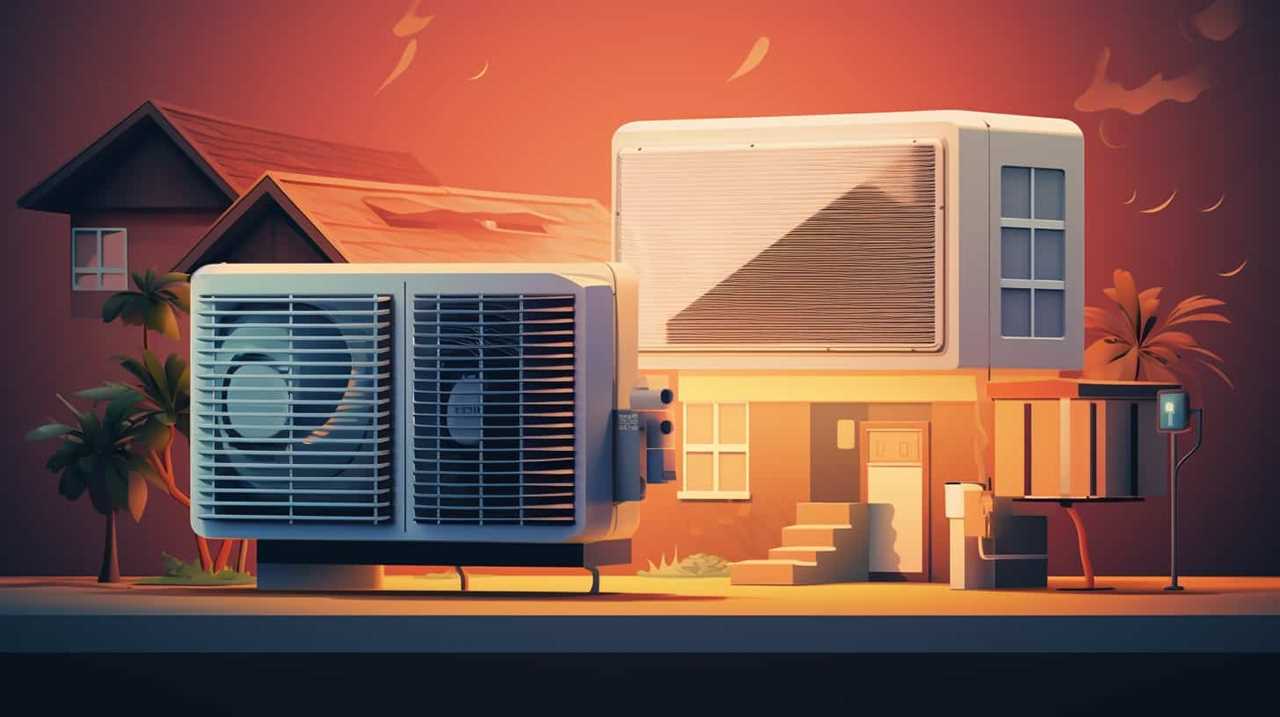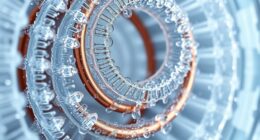Having trouble maximizing your heat pump’s efficiency? We get how annoying that can be. That’s why we’ve put together 13 essential steps to enhance its functionality.
From understanding the refrigeration cycle to choosing the right refrigerant, we’ve got you covered. With proper sizing, installation, and maintenance, you can ensure efficient heat exchange and prevent potential air leaks.
Plus, we’ll show you how to maximize performance in different climate zones and utilize energy-saving features. Let us help you serve your heat pump better.
Key Takeaways
- Understand the refrigeration cycle and choose the right refrigerant for efficient heat exchange and low environmental impact.
- Ensure proper sizing and installation of heat pump equipment to maximize efficiency and effectiveness.
- Maintain adequate airflow and clean heat exchange surfaces regularly for optimal heat transfer.
- Optimize compressor performance, utilize advanced technologies, and implement effective control strategies to enhance heat pump performance.
Understanding the Refrigeration Cycle in Heat Pumps
Let’s delve into the intricacies of the refrigeration cycle in heat pumps to gain a comprehensive understanding of its operation. The refrigeration cycle is a vital component of heat pump systems, responsible for transferring heat from one place to another. It consists of four main stages: compression, condensation, expansion, and evaporation.

During the compression stage, the refrigerant is compressed, causing its temperature and pressure to rise. This high-pressure, high-temperature gas then flows into the condenser, where it releases heat and condenses into a liquid. The liquid refrigerant then enters the expansion valve, where it undergoes a pressure drop, resulting in a decrease in temperature. This cool liquid then enters the evaporator, where it absorbs heat from the surrounding environment and evaporates into a gas.
Understanding the refrigeration cycle is crucial for troubleshooting any issues that may arise in heat pump systems. By identifying potential problems in the compression, condensation, expansion, or evaporation stages, technicians can address them promptly to ensure optimal heat pump energy efficiency.
Now that we’ve a solid understanding of the refrigeration cycle in heat pumps, let’s move on to the next section, which focuses on choosing the right refrigerant for optimal performance.
Choosing the Right Refrigerant for Optimal Performance
To achieve optimal performance, we must carefully select the right refrigerant for our heat pump system. The choice of refrigerant plays a critical role in determining the efficiency and overall performance of the heat pump.
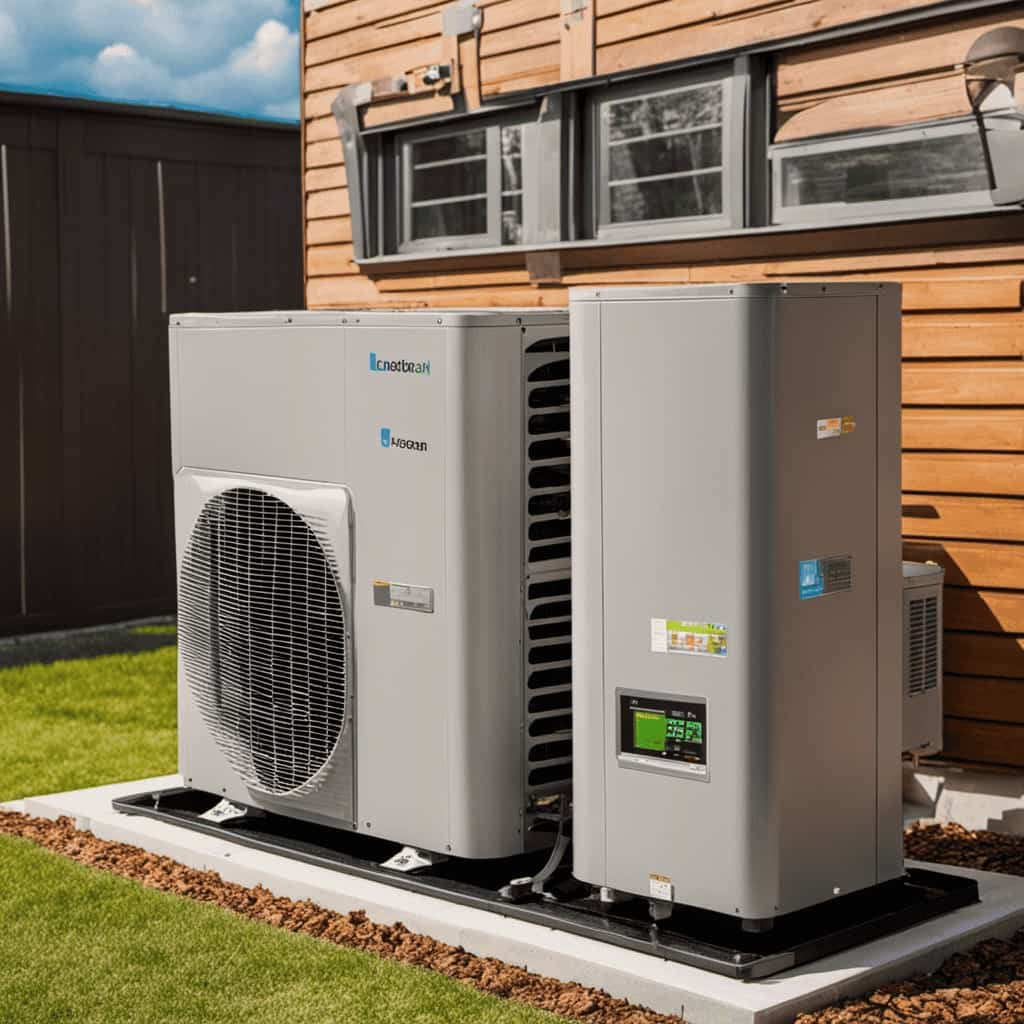
When considering refrigerant options, it’s important to take into account several performance factors:
-
Heat Transfer Efficiency:
-
The refrigerant should have a high heat transfer coefficient to ensure efficient heat exchange between the indoor and outdoor environments.
-
It should also have a low boiling point and high latent heat of vaporization to facilitate the heat transfer process.

-
Environmental Impact:
-
We must consider refrigerants with low global warming potential (GWP) and ozone depletion potential (ODP) to minimize their impact on the environment.
Proper Sizing and Installation of Heat Pump Equipment
When it comes to heat pump equipment, proper sizing and installation are crucial for optimal performance.
Correct sizing ensures that the heat pump is able to meet the heating and cooling demands of the space, while expert installation guarantees that the equipment operates efficiently and effectively.

Errors in sizing or installation can have a significant impact on the heat pump’s efficiency, leading to higher energy consumption and reduced comfort levels.
Importance of Correct Sizing
As we delve into the importance of correct sizing for heat pump equipment, it’s crucial to ensure proper installation and sizing to optimize performance.
Correct sizing benefits both the equipment and the occupants of a building in several ways:
-
Efficient operation: Properly sized heat pump equipment ensures that the system operates at its optimal capacity, resulting in improved energy efficiency and reduced utility costs.

-
Comfortable indoor environment: Sizing considerations include the specific heating and cooling needs of a space. By selecting the right size, the heat pump can effectively maintain a comfortable temperature throughout the building.
-
Avoiding frequent cycling: Oversized equipment can lead to frequent on-off cycling, causing temperature fluctuations and discomfort.
-
Preventing inadequate heating or cooling: Undersized equipment may struggle to meet the demand, resulting in poor performance and inadequate temperature control.
Expert Installation Benefits
For optimal performance, we must ensure the proper sizing and installation of heat pump equipment. Expert installation benefits play a crucial role in maximizing the efficiency and effectiveness of these energy-saving technologies.
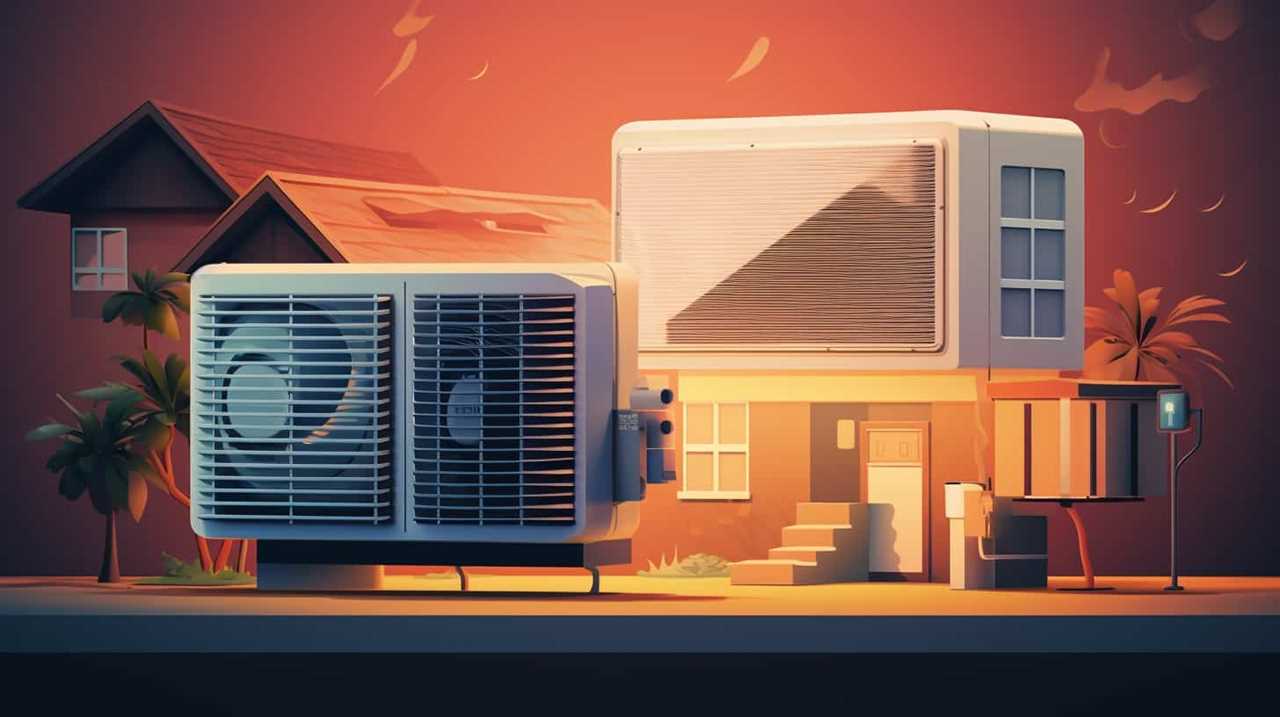
When it comes to heat pump installation, relying on professionals ensures that the equipment is sized correctly for your specific needs. This means that the heat pump will be able to provide the desired heating or cooling capacity without wasting energy.
Expert installers are also knowledgeable about the latest energy-saving technologies and can recommend the most efficient equipment for your home or business.
Additionally, proper installation ensures that all components are connected correctly and that the system operates at its highest efficiency.
Efficiency Impact of Errors
Proper sizing and installation of heat pump equipment significantly impact the efficiency of the system. Reducing errors in these areas is crucial for optimizing performance.
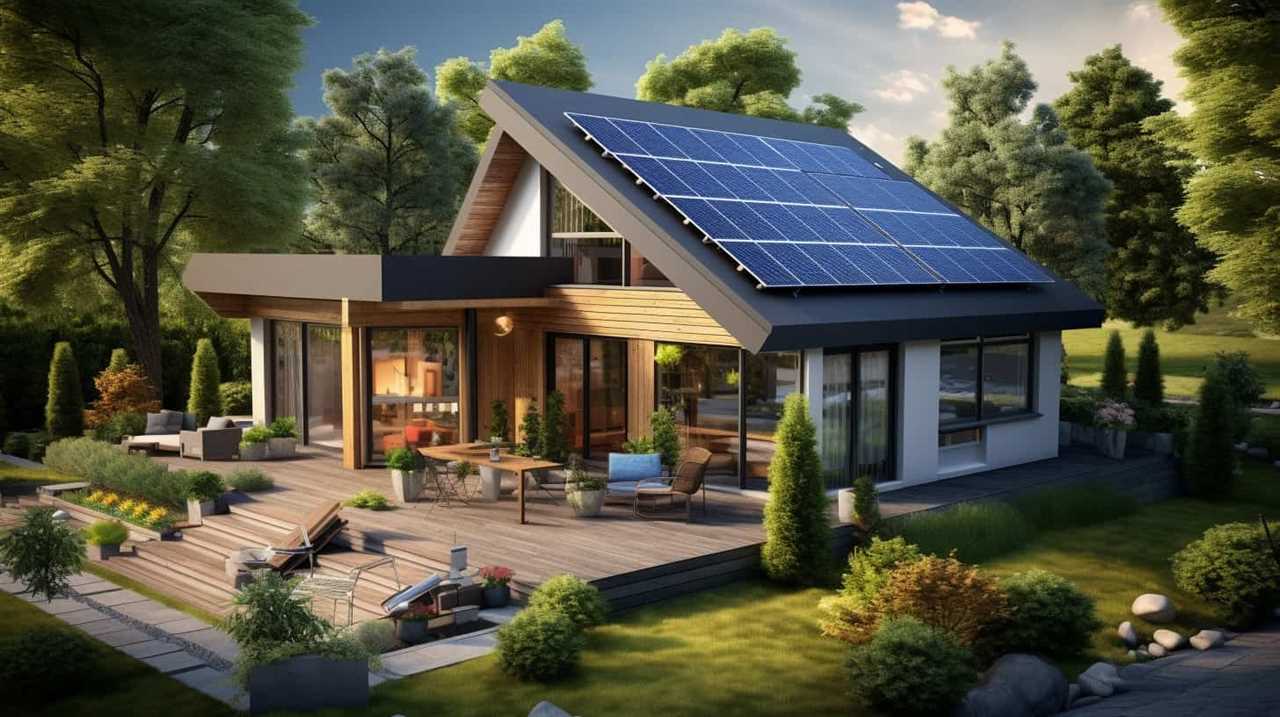
Here are two key ways in which errors can have a performance impact:
-
Sizing Errors: Incorrectly sizing the heat pump can lead to inefficiencies. If the unit is oversized, it may cycle on and off frequently, wasting energy. Conversely, an undersized unit may struggle to meet the heating or cooling demand, resulting in poor comfort and increased energy consumption.
-
Installation Errors: Improper installation can also undermine the heat pump’s efficiency. Common installation errors include inadequate insulation, improper refrigerant charge, and poor ductwork design. These errors can lead to energy losses, reduced performance, and increased wear and tear on the system.
Ensuring proper sizing and installation is essential for maximizing efficiency and minimizing energy consumption. However, it’s equally important to ensure adequate airflow in the heat pump system, which we’ll discuss in the next section.

Ensuring Adequate Airflow in the Heat Pump System
We need to ensure that there’s adequate airflow in the heat pump system to optimize its performance. Proper ventilation is crucial for the efficient operation of the heat pump. Insufficient airflow can lead to decreased efficiency, reduced heating or cooling capacity, and increased energy consumption.
To ensure proper ventilation, it’s important to regularly clean or replace air filters. Clogged filters restrict airflow and force the heat pump to work harder, reducing its efficiency. Additionally, make sure that there are no obstructions around the outdoor unit, such as vegetation or debris, as this can impede airflow.
Regular maintenance and inspections by a qualified technician can help identify and address any airflow issues in the heat pump system, ensuring optimal performance and energy savings.
Maintaining Clean and Efficient Heat Exchange Surfaces
We regularly clean the heat exchange surfaces to ensure they remain clean and efficient. Maintaining the cleanliness of heat exchange surfaces is crucial for optimal heat pump performance and energy efficiency. Here are the key steps we follow for heat exchanger maintenance:

-
Visual inspection: We visually inspect the heat exchange surfaces regularly to identify any signs of dirt, debris, or corrosion.
-
Cleaning: If we observe any buildup of dirt or debris, we clean the surfaces using appropriate cleaning solutions and tools to remove any contaminants.
-
Mechanical cleaning: For stubborn deposits, we use brushes or pressure washing to dislodge and remove them.
-
Chemical cleaning: In some cases, we may utilize specialized chemical cleaners to dissolve and remove stubborn deposits.
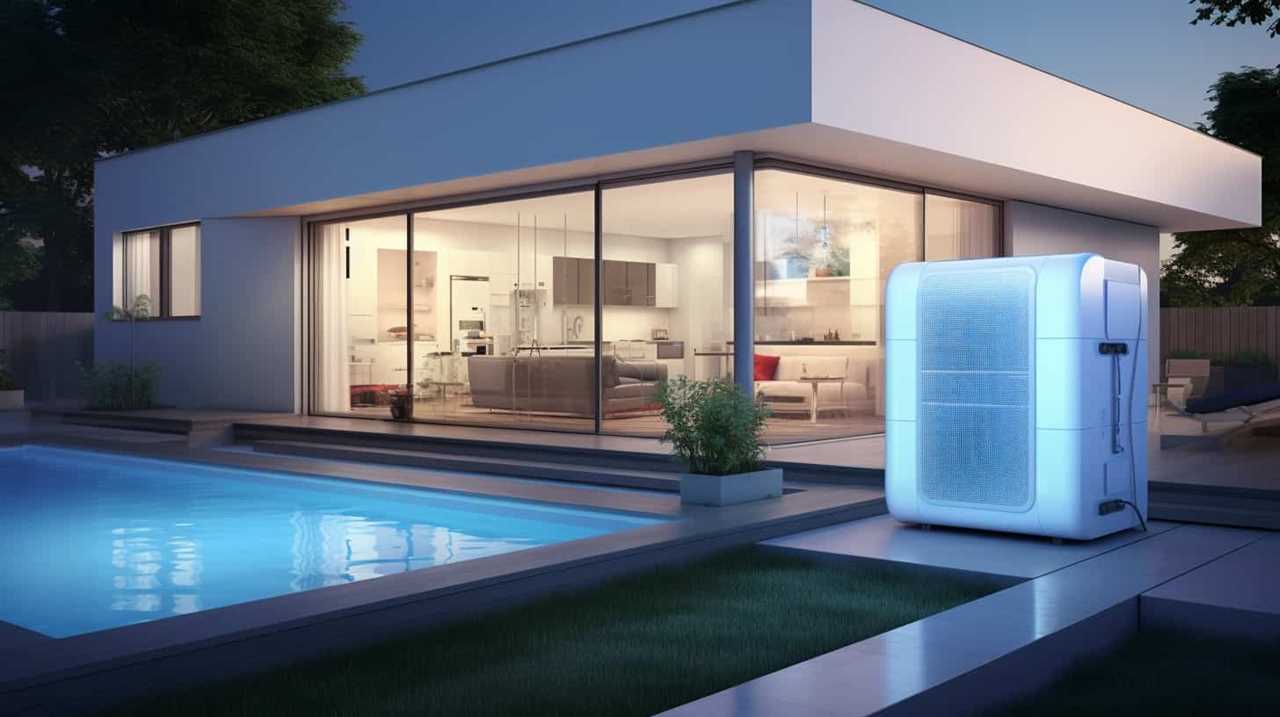
By regularly cleaning the heat exchange surfaces, we ensure efficient heat transfer, maximize energy efficiency, and prevent any potential issues that may arise due to clogged or inefficient heat exchangers.
Now, let’s discuss the next step in optimizing heat pump performance: optimizing the compressor performance for better efficiency.
Optimizing the Compressor Performance for Better Efficiency
When it comes to optimizing the performance of a heat pump, one crucial aspect to consider is the efficiency of the compressor. By enhancing the compressor performance, we can significantly improve the overall efficiency of the heat pump system.
This involves implementing strategies such as selecting the right compressor size, maintaining proper refrigerant charge, and regularly servicing the compressor to ensure optimal operation.

Compressor Efficiency and Optimization
To achieve better efficiency, we should focus on optimizing the performance of the compressor. The compressor is a critical component of a heat pump system and plays a crucial role in maintaining the desired temperature.
Here are key steps to optimize compressor efficiency:
-
Compressor Maintenance:
-
Regularly clean the compressor to remove dust and debris, ensuring efficient airflow.

-
Check and replace worn-out components, such as valves and seals, to prevent leaks and maintain optimal performance.
-
Energy Consumption:
-
Monitor and adjust the heat pump’s operating parameters, such as temperature and pressure, to minimize energy consumption.
-
Consider installing a variable speed drive (VSD) compressor, which adjusts its speed based on the required load, resulting in better energy efficiency.
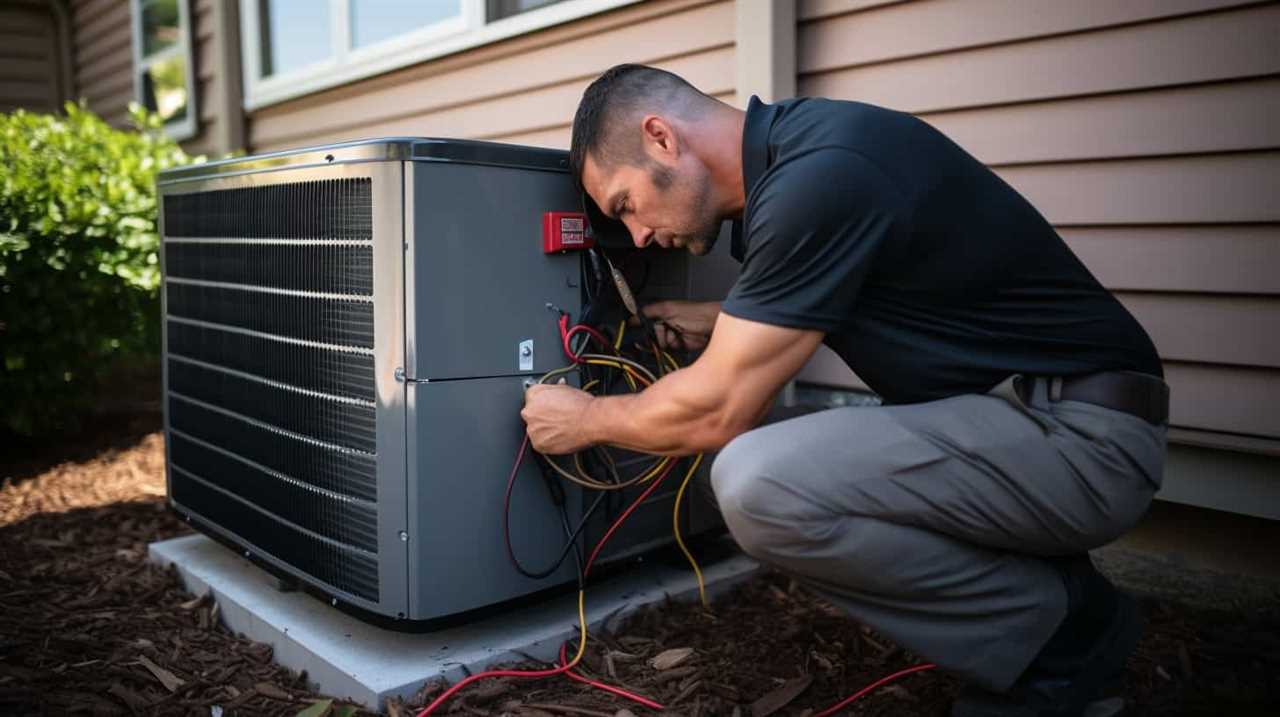
Optimizing the compressor’s performance through proper maintenance and energy management can lead to significant improvements in overall heat pump efficiency. By implementing these steps, you can ensure that your heat pump operates at its best, providing comfort while minimizing energy consumption.
Enhancing Heat Pump Performance
By optimizing the compressor performance, we can enhance the efficiency of the heat pump. Maximizing efficiency is crucial in order to reduce energy consumption and lower operating costs.
One way to improve heat transfer and maximize efficiency is by ensuring that the compressor is properly sized for the heat pump system. An undersized compressor can result in poor heat transfer and reduced performance, while an oversized compressor can lead to excessive energy consumption.
Additionally, using advanced compressor technologies, such as variable speed compressors, can further improve efficiency by matching the compressor’s output to the heat load requirements.
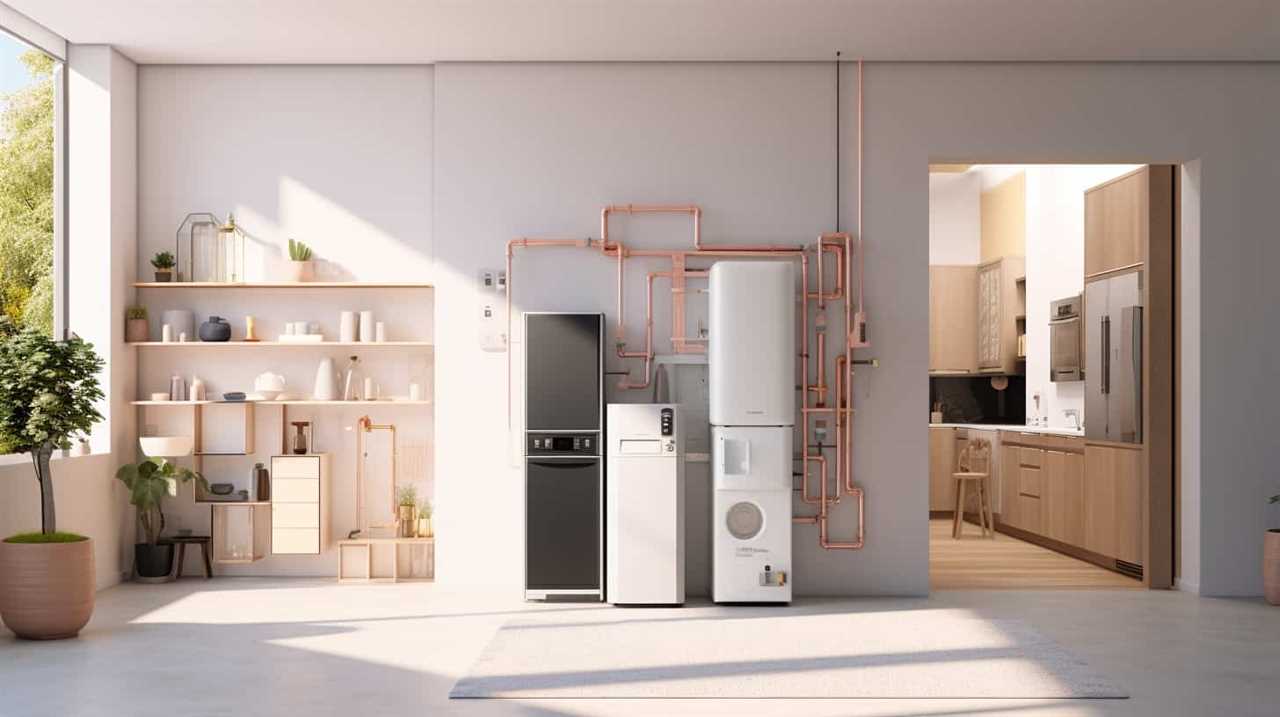
Implementing effective heat pump control strategies is the next step in optimizing heat pump performance, which we’ll discuss in the following section.
Now, let’s transition into the subsequent section about ‘implementing effective heat pump control strategies’.
Implementing Effective Heat Pump Control Strategies
As we delve into the topic of implementing effective heat pump control strategies, it’s important to consider the various factors that can optimize performance. By improving efficiency and utilizing smart controls, we can ensure that heat pumps operate at their highest potential.
Here are two key strategies to implement:
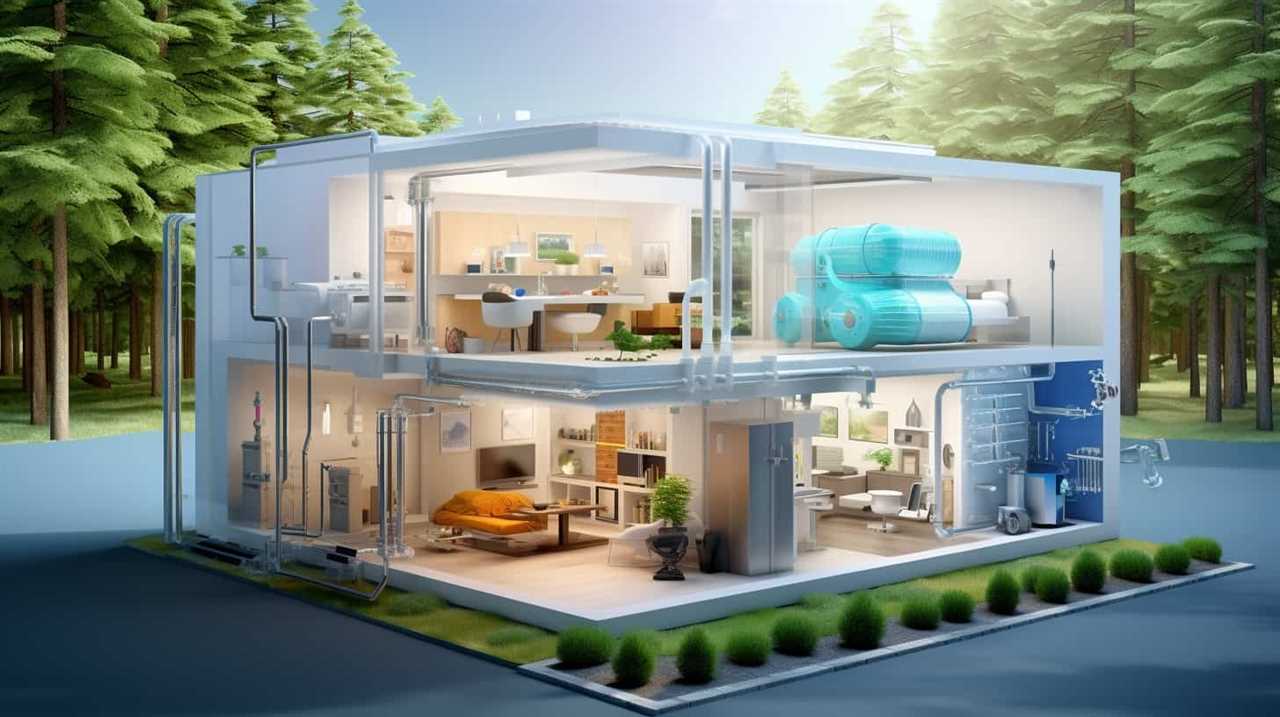
-
Utilize advanced control algorithms: Smart controls can continuously monitor and adjust the heat pump’s operation based on factors such as outdoor temperature, indoor occupancy, and energy demand. By dynamically optimizing settings, these algorithms ensure that the heat pump operates at its most efficient level at all times.
-
Incorporate variable speed technology: By utilizing variable speed compressors and fans, heat pumps can adjust their output to match the heating or cooling demand. This enables precise temperature control and minimizes energy wastage. Additionally, variable speed technology reduces start-stop cycles, resulting in less wear and tear on the system.
Implementing these effective control strategies won’t only improve efficiency but also enhance the overall performance of heat pumps, providing optimal comfort and energy savings for users.
Regularly Monitoring and Adjusting Refrigerant Charge
We must regularly monitor and adjust the refrigerant charge to ensure optimal heat pump performance. The refrigerant charge in a heat pump plays a crucial role in its overall efficiency and ability to transfer heat effectively. Keeping the refrigerant charge at the manufacturer’s specified levels is essential for maximizing energy efficiency and preventing system malfunctions.
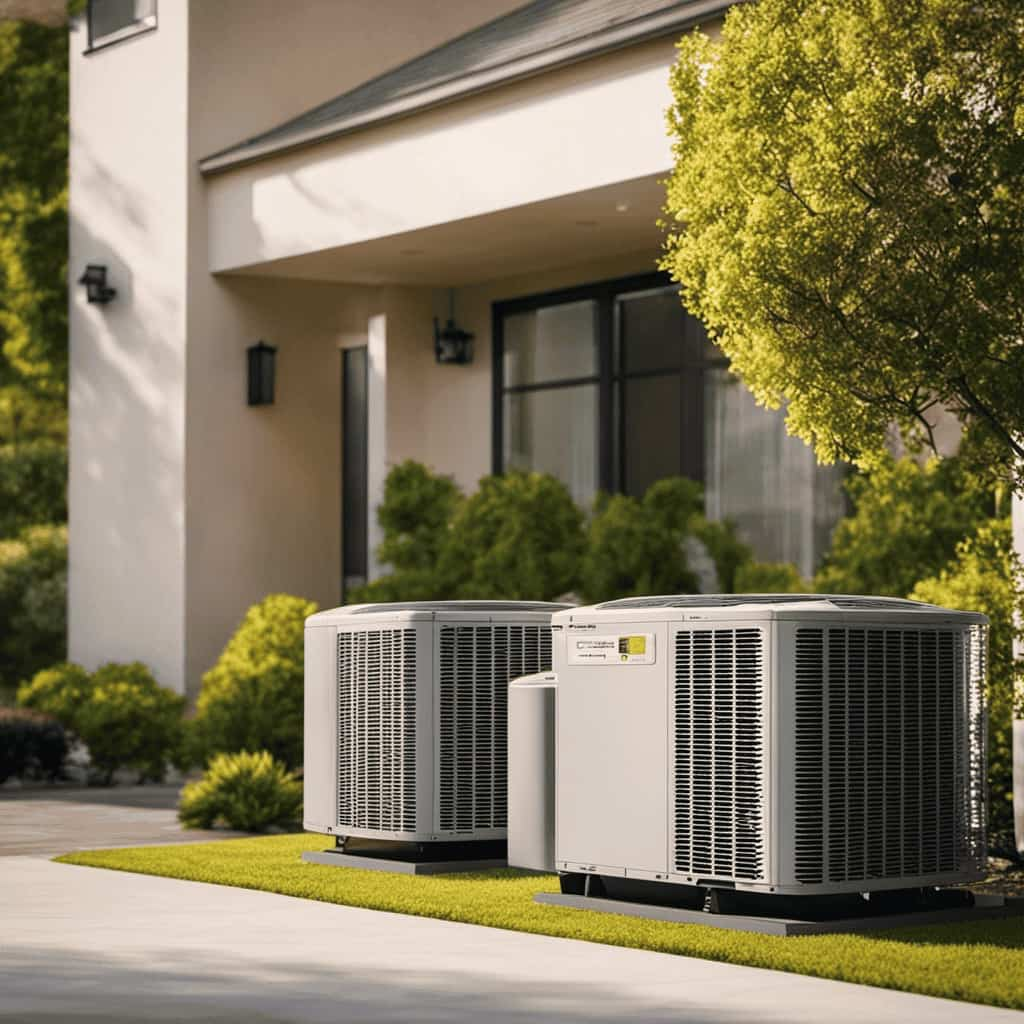
To optimize the refrigerant charge, various monitoring techniques can be employed. These include measuring the superheat and subcooling values, which indicate the amount of refrigerant in the system. By comparing these values with the recommended ranges, adjustments can be made to achieve optimal performance.
Additionally, using advanced monitoring tools such as digital gauges and pressure sensors can provide real-time data on the refrigerant charge, allowing for quick adjustments and preventing potential issues.
Regularly monitoring and adjusting the refrigerant charge is a key step in maintaining the efficiency and longevity of a heat pump system.
Properly Insulating the Refrigerant Lines to Minimize Heat Loss
To minimize heat loss, we should properly insulate the refrigerant lines. This step is crucial in preventing energy waste and maximizing the efficiency of the heat pump system. Here are two important reasons why proper insulation is necessary:

-
Preventing heat transfer: Insulating the refrigerant lines helps to minimize heat loss during the transportation of refrigerant between the indoor and outdoor units. By reducing heat transfer, we can ensure that the refrigerant reaches its destination at the desired temperature, improving the overall performance of the heat pump.
-
Maintaining system efficiency: Insulation also helps to prevent condensation and moisture buildup on the refrigerant lines. This is important because moisture can lead to corrosion and damage to the system components, ultimately reducing the efficiency and lifespan of the heat pump.
Addressing Potential Air Leaks in the Heat Pump System
Let’s start by discussing the first point, which is detecting hidden air leaks in the heat pump system.
Air leaks can significantly impact the efficiency and performance of the system, leading to increased energy consumption and decreased comfort levels. By conducting a thorough inspection, using tools like smoke pens or infrared cameras, we can identify and locate any air leaks that may be present.

Once the leaks are detected, the next step is to seal the ductwork to maximize efficiency. Properly sealed ductwork ensures that the heated or cooled air is delivered directly to the intended areas, minimizing energy waste.
Regular maintenance is also crucial to address any potential air leaks that may develop over time, as well as to ensure the overall performance and longevity of the heat pump system.
Detecting Hidden Air Leaks
Our first step in addressing potential air leaks in the heat pump system is to detect hidden air leaks. Detecting airflow issues and troubleshooting common heat pump problems is crucial to ensure optimal heat pump performance.
Here are the key steps to detect hidden air leaks and address potential air leaks in the heat pump system:
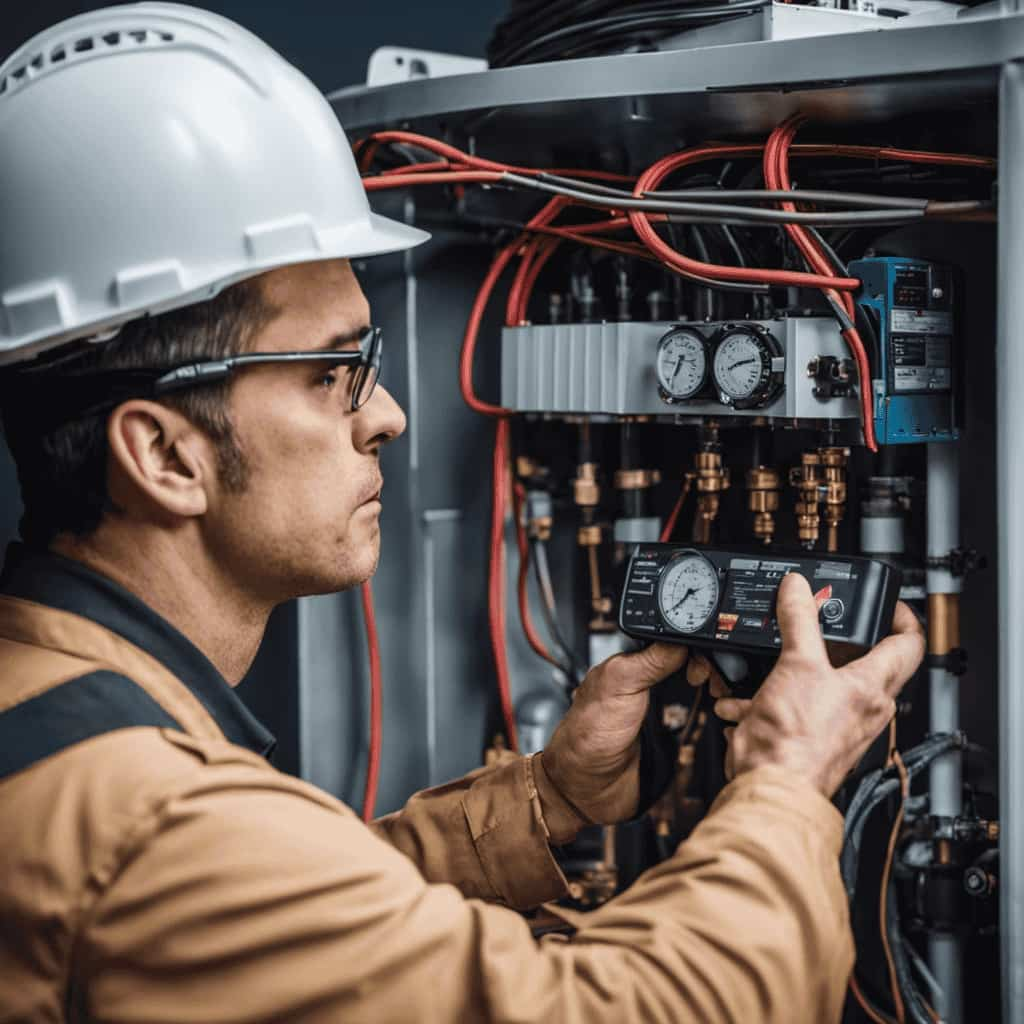
-
Visual inspection:
-
Check for any visible gaps or cracks in the heat pump unit or ductwork.
-
Look for signs of condensation or moisture around the unit, which can indicate air leaks.
-
Airflow testing:

-
Conduct a blower door test to measure the amount of air leakage in the system.
-
Use a smoke pencil or infrared camera to identify air leaks by observing the movement of smoke or temperature differences.
Sealing Ductwork for Efficiency
We can improve heat pump efficiency by sealing ductwork and addressing potential air leaks in the system. Properly sealed ductwork ensures that the conditioned air reaches its intended destination without any loss. One way to achieve this is through ductwork insulation, which helps maintain the desired temperature by minimizing heat transfer.
Insulating ductwork prevents energy losses and reduces the workload of the heat pump, resulting in improved efficiency. Additionally, an energy efficient duct design plays a crucial role in optimizing heat pump performance. This involves proper sizing, layout, and configuration of the duct system to minimize air leaks and pressure imbalances.

Importance of Regular Maintenance
To ensure optimal performance of the heat pump system, it’s important to regularly address potential air leaks. Regular maintenance is crucial for the efficient operation of the heat pump and can provide numerous benefits.
Here are two key reasons why addressing potential air leaks through regular maintenance is essential:
-
Improved Energy Efficiency: By sealing any air leaks in the heat pump system, you can prevent the loss of conditioned air. This ensures that the heat pump operates at its maximum efficiency, reducing energy consumption and saving you money on utility bills.
-
Enhanced Indoor Comfort: Addressing air leaks helps maintain a consistent temperature throughout your home. By preventing drafts and hot or cold spots, you can create a more comfortable living environment for yourself and your family.
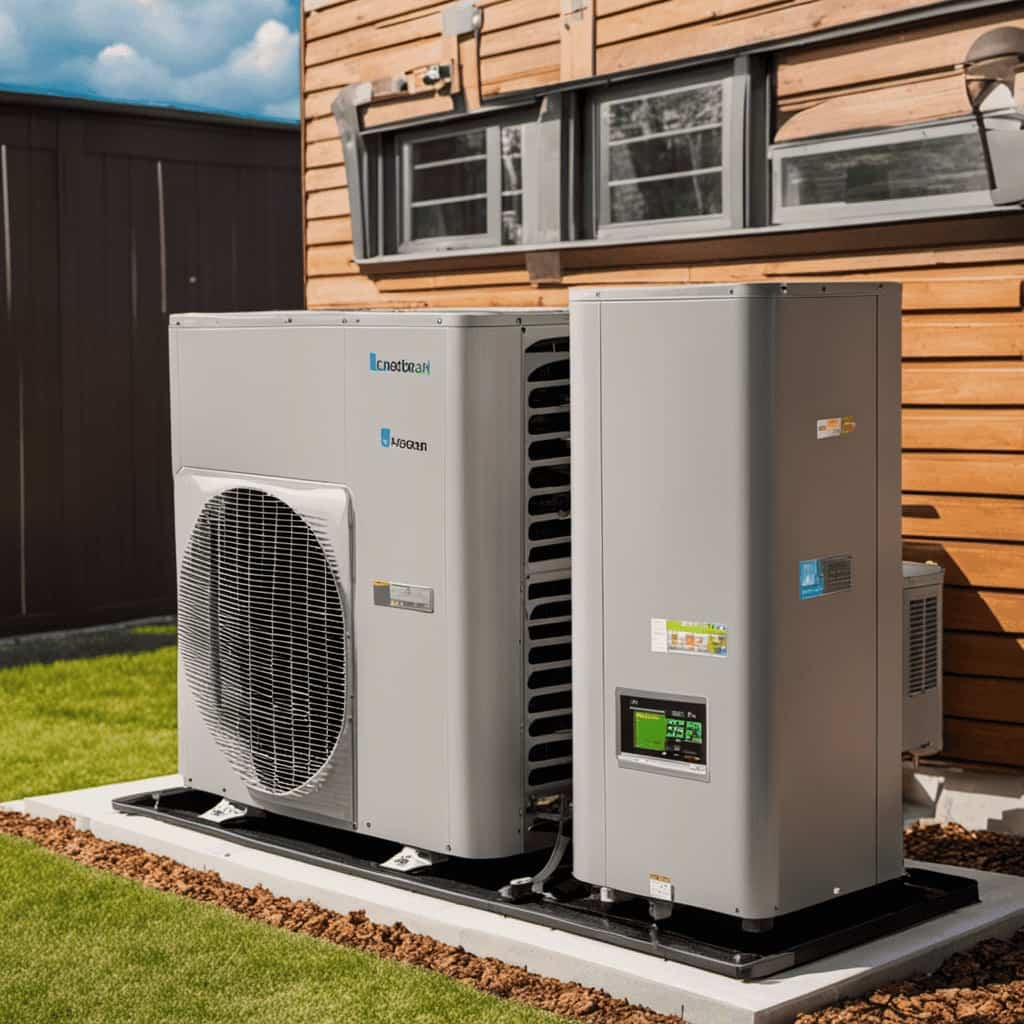
To enjoy these benefits, it’s recommended to follow a regular maintenance schedule and have a professional technician inspect and seal any potential air leaks in your heat pump system.
Maintenance and Cleaning of Heat Pump Coils and Filters
Regular maintenance and cleaning of heat pump coils and filters is essential for optimal performance. Neglecting these tasks can lead to reduced efficiency, increased energy consumption, and even system breakdowns. To ensure the longevity and efficiency of your heat pump, it is important to follow proper maintenance techniques and troubleshooting tips. Here are some key steps to help you maintain and clean your heat pump coils and filters:
| Maintenance Techniques | Troubleshooting Tips |
|---|---|
| Regularly clean the coils and filters to remove dirt, debris, and dust. | If the heat pump is not producing enough heat or cool air, check the coils and filters for clogs or blockages. |
| Inspect the coils for any signs of damage or corrosion. | If the heat pump is making unusual noises, it could indicate a problem with the coils or filters. |
| Replace or repair any damaged coils or filters as soon as possible. | If the heat pump is constantly cycling on and off, it may be due to a dirty or clogged filter. |
| Schedule professional maintenance at least once a year to ensure proper functioning. | If the heat pump is not turning on at all, check the coils and filters for any issues. |
Optimizing Heat Pump Performance in Different Climate Zones
In order to optimize heat pump performance in different climate zones, it’s important to adjust settings and settings and settings and settings and settings and settings and settings and settings and settings and settings and settings and settings. This adjustment is crucial due to the climate change impact, which affects the way heat pumps operate.
To serve our audience effectively, we need to provide detailed information on optimizing heat pump performance in different climate zones. Here are two key considerations:

- Climate Analysis:
- Conduct an energy consumption analysis to determine the specific climate conditions in the area.
- Consider factors such as temperature range, humidity levels, and seasonal variations.
- System Settings:
- Adjust the thermostat settings to match the climate zone, ensuring efficient operation.
- Fine-tune the defrost cycle to prevent unnecessary energy consumption during colder climates.
Utilizing Energy-Saving Features and Technologies in Heat Pumps
By implementing energy-saving features and technologies, we can enhance the performance of heat pumps. Energy-saving features are designed to reduce energy consumption and optimize the efficiency of heat pumps. One such feature is variable-speed technology, which allows the heat pump to adjust its speed according to the heating or cooling demand. This not only reduces energy waste but also improves comfort by providing more precise temperature control.
Another energy-saving feature is smart thermostats, which enable users to program their heat pumps for optimal efficiency. These thermostats can learn the user’s preferences and adjust the temperature accordingly, saving energy when the space is unoccupied.
Additionally, heat pump technologies such as geothermal heat pumps and air-source heat pumps utilize renewable energy sources, further reducing energy consumption and environmental impact. Incorporating these energy-saving features and technologies into heat pumps can significantly improve their performance and efficiency.
Frequently Asked Questions
What Are the Benefits of Regularly Monitoring and Adjusting Refrigerant Charge in a Heat Pump System?
The benefits of regular monitoring and adjusting refrigerant charge in a heat pump system can be summarized as improved energy efficiency, reduced costs, extended equipment lifespan, and enhanced comfort levels.

How Can Proper Insulation of Refrigerant Lines Minimize Heat Loss in a Heat Pump System?
Proper insulation of refrigerant lines is crucial in minimizing heat loss in a heat pump system. It ensures efficient heat transfer and prevents energy waste. Insulation acts as a protective barrier, keeping the refrigerant lines insulated and reducing heat loss.
What Are Some Effective Heat Pump Control Strategies That Can Be Implemented to Optimize Performance?
Heat pump control techniques are crucial for optimizing performance. Regular maintenance ensures optimal efficiency and prevents issues that can affect performance. We’ll discuss effective strategies and the importance of maintenance for heat pump performance.
How Do Different Climate Zones Affect the Optimization of Heat Pump Performance?
Different climate zones have varying effects on heat pump performance. Factors such as temperature, humidity, and air quality can impact the efficiency and effectiveness of different heat pump models. Proper optimization is crucial for optimal performance.
What Are Some Energy-Saving Features and Technologies That Can Be Utilized in Heat Pumps to Improve Efficiency?
To improve heat pump efficiency, energy efficient compressors and smart thermostats can be utilized. These features and technologies help optimize performance and save energy, making our heat pumps more efficient and cost-effective.

Conclusion
Well, congratulations! You’ve made it through all 13 key steps to optimize heat pump performance.
Now, armed with this wealth of knowledge, you can confidently navigate the complex world of heat pumps.
Remember, it’s all about understanding the refrigeration cycle, choosing the right refrigerant, proper sizing and installation, and addressing potential issues.
So go forth and conquer the heat pump world, my friends, and may your efficiency be ever optimized.
